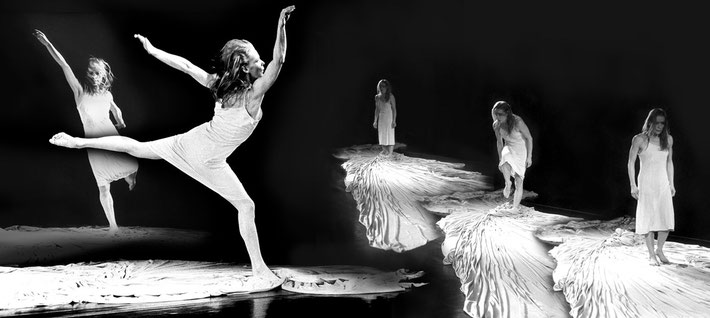International press reviews from the first solo dance phase (1982 - 1987)
THE TIMES (London), The New York Times (N.Y.-USA),
The Times of India (Bombay), Le Monde (Paris), Le Figaro (Paris) etc...
EARLY CRITICS from the first solo dance phase
John Percival, THE TIMES, London (GB), 1982:
She has an impressive technique (amazing balances in arabesques and fast walking on barefoot three quarter point, for instance, in Tchaikovsky) but it is always used for expression... A memorable image.
Mary Clark, Arts Guardian, Glasgow (GB), 1982:
... it was fascinating to see a dancer so commited to use the floor, so uncompromising in here statements about the downward pull of gravity... It is a dance style not these days well known here, but it´s a powerful one.
Jann Perry, Dance & Dancers, London (GB), 1982:
The best word to describe Susanne Linke is "statuesque". Blonde, beautiful, wide-shouldered, she looks in her long draped dressed like a piece of Art Déco... She is a graphic example of how polarised European modern dance has become from American post-post moderns. She is fuelled by intensity, they by explosive energy.
Sumitra Srinivasan, The Times of India, Bombay (IND), 1984:
Susanne´s symbolism and her innovative choreography were a joy to watch. In her dance there is an elemental symbiosis of music and movement. With tremendous control her body seemed to propel itself into its own cadences of rhythm.
Jennifer Dunning, The New York Times, N.Y. (USA), 1984:
A highlight of the evening was the American premiere of "Flood" a solo created by Susanne Linke... "Flood" could be a metapher for the life. But what is most compelling is the powerful physical presence of the performer, which calls to mind Wigman´s stark expressiveness.
Hindhustan Times, Neu Delhi (Indien), 11.11.1985:
There are elements in Susanne Linke´s dance that defy my vocabulary. How does one capture birdflight in all its
suddeness, vulnerability yet allow-like precision? Or poetry´s gift to be both cosmic and microcosmic at the same time? How does one coavey the essence of humanity, pulled down again and again like primeval Kundalini Shakti?
Linke´s dance had images that did this so effordlessly, so beautifully that it became at once the collective expression of humanity as well as her own personal statement. Having watched the Guru of post-modern dance, Merce Cunningham and his troupe only a few month ago at Avignon, having also had the opportunity to see such brilliant perfectionists of the European scene as Karole Armitage, also at that venue, I know now what it is in
Linke´s dance that strikes a special chord in the Indian viewer.
Village Voice, New York, October 13th, 1987:
In Montreal, watching Susanne Linke perform the same solos that I saw last year at BAM, I realized what I´d been missing all week, in Chouinards´s artfully erotic sculptures as well as in the imaginative athleticism of the companies reviewed last week: nuanced phrasing, steps set in coherent, variegated sequences; clarity of feeling and image. If the standing, cheering spectators thought Linke´s craftmanship old-fashioned, they didn´t let on.

Anna Kisselgoff, The New York Times, December 22th, 1985:
For this reason, Miss Linke is of particular interest. She diverges from the German dance-theater genre, at least as a solist. And while another American in the festival, Carolyn Carlson, offered a more coherent solo presentation (a reverie that- true to her Nicilai training - never used psychological body language), Miss Linke managed to create a theater of her own, out of her body. True props were present. But even when they were literal as a bathtub or a toilet seat in "Bath Tubbing", the prosaic everyday elements of real life became a springboard for a metaphoric meditation. In this solo, Miss Linke scooted around the tub, wiping its rim with a towel, and shot off to the floor. She returned to seesaw atop the tub, to dip in an arm or her torso. This high drama was contrasted with woman-as-char, scrubbing the floor or with a virtuoso display of muscular control as the dancer used the tub for minimal support. Finally, the tub tumbled to one side and Miss Linke lay in it and then rolled outside - unsheltered.
Marcelle Michelle, Le Monde, Paris (F), 1982:
Toujours, chez Susanne Linke, le contrôle musculaire est parfait, la coordination des gestes totale. L´intériorité transfigure son visage... Jamais Line n´est aussi belle que lorsqu´elle dialogue avec le sol et tente d´échapper à son attirance.
Gilberte Cournand, Le Parisien, Paris (F), 1982:
D´une rayonnante beauté, Susanne Linke s´impose par la force, la grâce, le dynamisme et la concentration de sa danse.
Raphael de Gubernatis, Le Nouvel Observateur, Paris (F), 1982:
Un cri, non: une plainte, muete et résigneé, l´expression d´une solitude sans rémission, bouleversante.
Simone Dupuis, L´express, Paris (F), 1982:
Allemande jusqu´au bout des ongles, Susanne Linke affronte à rebroussepoil vingt ans d´abstraction américaine.
Ses armes: théâtralité, symbolisme, réalisme. Son obsession: la femme, asservie mais fascinante, et victorieuse
en fin de compte.
René Sirvin, Le Figaro, Paris (F), 1982:
Drôles ou pathétiques, toujours insolites, les solos de Susanne Linke provoquent chez le spectateur une curieuse
impression de malaise et de ravissement. Au-delà de l´apparence formelle se dégage un sentiment trouble, inquiétant parce qu´imprécis et peut-être purement subjectif. En trois temps, quatre solos, sans temps mort, Susanne Linke exprime l´angoisse de toute une génération, la lutte épuisante de la femme en contradiction avec elle-même, la souffrance de l´être qui cherche à s´assumer et à donner un sense à sa vie.
Brigitte Kehrer, Tribune de Genève, Genf (CH), 1983:
Susanne Linke, cést bouleversant. L´expressionisme de Susanne Linke est la marque d´une singulière compression révélée dans l´immédiateté, intégrant la grâ des origines.
Jean-Pierre Pastori, Journal de Genève, Genf (CH), 1983:
La beauté de cette danseuse au corps parfait et dont les longs cheveaux blonds, saisis par le movement, forment comme un halo solaire autour d´elle.




